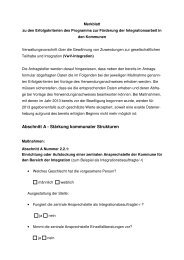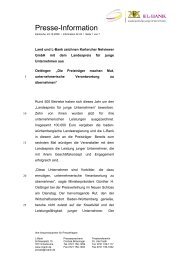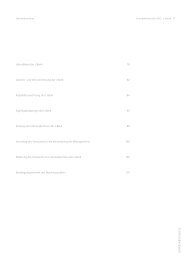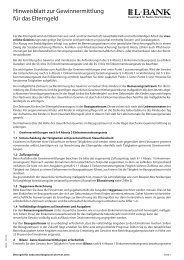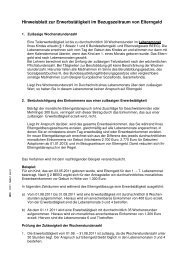Landeskreditbank Baden-Württemberg - L-Bank
Landeskreditbank Baden-Württemberg - L-Bank
Landeskreditbank Baden-Württemberg - L-Bank
Create successful ePaper yourself
Turn your PDF publications into a flip-book with our unique Google optimized e-Paper software.
Notes to the annual financial statements for<br />
the financial year ended December 31, 2004<br />
General principles<br />
<strong>Landeskreditbank</strong> <strong>Baden</strong>-Württemberg – Förderbank (L-<strong>Bank</strong>) was established by legislation passed on<br />
November 11, 1998, which came into effect on December 1, 1998. In accordance with § 2 para. 1 subpara. 1 of<br />
the L-<strong>Bank</strong> Act, the share capital of the <strong>Bank</strong> is EUR 250 million.<br />
The financial statements for L-<strong>Bank</strong> have been drawn up in accordance with the provisions of the German<br />
Commercial Code (Handelsgesetzbuch [HGB]) and the Regulation on the Accounting Principles Applied to<br />
Credit Institutions (Verordnung über die Rechnungslegung für Kreditinstitute [RechKredV]).<br />
Headings and items on the balance sheet and statement of income are classified in accordance with the financial<br />
statement forms that appear in RechKredV. In the process, L-<strong>Bank</strong> has added an extra item to the expenses side<br />
of the statement of income, “Allocation to reserves for interest rate reductions” (§ 265 para. 5 HGB).<br />
The majority interests declared in the financial statements are of minor significance overall. For this reason the<br />
<strong>Bank</strong> did not prepare consolidated financial statements for the period (§ 296 para. 2 HGB).<br />
Foreign currency translation principles<br />
Foreign currency amounts have been translated in accordance with the provisions set out in § 340h HGB and<br />
declaration BFA 3/95. Assets and liabilities denominated in foreign currencies, together with unprocessed spot<br />
exchange transactions, have been translated at the middle spot rate on December 30, 2004, being the last day of<br />
the year on which there was a liquid foreign exchange market.<br />
For purposes of currency translation, currency items have been calculated by offsetting claims and<br />
obligations arising from on-balance-sheet and off-balance-sheet transactions in the respective currencies. These<br />
transactions were classified and valued using the special cover option in the respective currencies. Accordingly,<br />
all expenses and earnings arising from currency translation are shown in the income statement as required by §<br />
340h para. 2 subparas. 1 and 2 HGB; there was no requirement to show any such income under a separate<br />
heading as the items outstanding on the balance sheet date fall within the same timeframe.<br />
Methods of accounting and valuation<br />
Assets, liabilities and pending transactions have been valued in accordance with the general provisions of §§ 252<br />
ff. HGB, taking into account the special rules applying to credit institutions (§§ 340e ff. HGB).<br />
Receivables from credit institutions and customers are generally shown at par value, liabilities to credit<br />
institutions and customers at redemption value. Any interest-based differences (premiums or discounts) relating<br />
to receivables and liabilities are shown under deferrals and pre-payments and written back pro rata temporis.<br />
Service charges are entered immediately. Low-interest or non-interest-bearing receivables are discounted.<br />
Reserves for interest rate subsidies are set up to cover loans made under the auspices of development programs.<br />
Zero bonds and similar securities issued are shown at the issue price plus interest calculated up to the balance<br />
sheet date pro rata temporis.<br />
All recognized individual risks and country risks arising out of the <strong>Bank</strong>’s lending business were<br />
appropriately provided for, either by accumulated amortization for losses on individual loan accounts or by<br />
reserves. Lump-sum reserves have been established to cover latent credit risks, and the <strong>Bank</strong> maintains<br />
prudential reserves to cover general banking risks. Individual provisions and lump-sum reserves have been<br />
deducted from the assets or liabilities side as appropriate, as has the reserve for general banking risks set up in<br />
compliance with § 340f HGB.<br />
F-8



